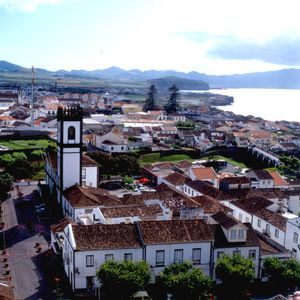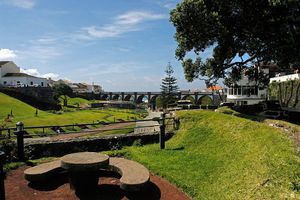
Ribeira Grande, São Miguel Island
Discover Ribeira Grande one of the most lively areas of São Miguel Island, Açores
Ribeira Grande is the second most populated area in São Miguel Island, Azores. This town was badly damaged by an eruption on 1263 in Lagoa do Fogo, since floods destroyed most of the houses just a year later, and by the 1680 earthquake. However, today it is an ordered and monumental city.
The town is divided in half by the river, and communicated by two bridges, one from the 19th century. Between both bridged, you can find the Ribeira dos Moinhos park, full of colourful paths and a “children’s paradise.”
The Praça da Càmara Municipal hosts a park full of metrosideros shrubs, a lookout with views over the river mouth, and the Paços do Concelho (17th-18th century), worth noting for their square clock tower with battlements, as well as for the wide vaulted passage in the centre of the façade, inside of which you can see a gallery with portraits of the constitutional Presidents of Portugal. Here also stands the Igreja do Espírito Santo church, with a Rococó façade and double door, lavishly decorated and fanciful.
In a superior plane, lies the newer square, with the music stand and the statue to vicar Dr. Gaspar Frutuoso (1552-1591), a historian and poet author of Saudades da Terra. From the square, you can access through a grand staircase to the Igreja Matriz de Nossa Senhora da Estrela, with the sacristy converted into a little museum with pieces such as Flemish Triptych, reliefs, and goldsmithing. The choir houses the “Arcano de Madre Margarita del Apocalipsis” from the 19th century.
To the north, over the cliff, lies the Ermida de Santa Lucía Shrine , whereas the Ermida de Santo André Hermit stands nearby a long gone castle and the current “poças de baño”.
If you cross the superior bridge, that leads to the Ribeira Grandese Theatre (1993) you can visit the Igreja da Conceição (17th century), the iron market (19th century), and - towards the outer part of the city - the São Francisco Convent, Baroque in style and currently used as hospital.
In the highest part of the town, it’s worth visiting the Casa da Cultura (Cultural Centre), located in the Capela de São Vicente Chapel, from them 18th century. The centre exhibits archaeological pieces. To finish the visit to Ribeira Grande, you can discover the Eduardo Ferreira Liquor Factory and the Franciscan Order Life Museum, in an imposing church closed for more than thirty years.
Outside the city, but still within the district of Ribeira Grande, it’s worth visiting the fishing town of Porto Formoso, with Praia dos Moinhos Beach, and the Nossa Senhora de Graça Fort. One kilometre from the latter, you can also find the Chã Gorreana Factory.
Ribeira Grande is the best base camp to explore the area of the Serra de Água de Pau and the impressing Lagoa do Fogo. A steep access, quickly deepening the forest and giant ferns, offers a path to reach Caldeira Velha (6 kilometres away). A 300-metre deviation also will take you to a fumarole of iron-load water and thermal pool with a public picnic area.
Parallel to this route, there is another trail leading to the Caldeiras Balneary (three kilometres from the circumvention), built in 1811, and currently closed.From the balneary, you can continue along a narrow path towards Lombardas (6 kilometres away), surrounding the lush cliffs of Ribeira Grande, that are - in fact - the disfigured walls of a crater. Towards the east of Ribeira Grande, beyond Ribeirinha, you will find several lookouts, among them Santa Iria lookout and Ponta do Cintrão lookout. Towards the west, two fishing towns follow each other: Ribeira Seca, with the 18th-century Igreja de São Pedro Church, and Rabo do Peixe, with the Igreja do Bom Jesus Church, on top of a cliff.
It’s worth noting that the most lively and traditional festivities in Ribeira Grande are the ones of Cavaladas de São Pedro, on June 29th.
Mapa Interactivo:
São Miguel Island
What to see:
- Ponta Delgada
- Jardim José do Canto Garden
- Igreja de São Roque (Mother Church)
- Sete Cidades
- Miradouro do Vista do Rei Overlook
- Miradouro da Ponta do Sossego Lookout
- Miradouro Pico do Ferro Lookout
- Ribeira Grande
- Miradouro de Santa Iria Lookout
- Lagoa do Fogo
- Caldeira Velha
- Paços do Concelho (Ribeira Grande)
- Nordeste
- Mosteiros
- Vila Franca do Campo
- Ilhéu da Vila Franca do Campo
- Praia Agua d’Alto Beach
- Furnas
- Lagoa das Furnas
- Capelas
- Terra Nostra Botanical Garden
Why "Portugal Travel"?
Portugal Travel is an organization of Portuguese agencies whose objectives are:
- ✓ To make Portugal, its culture and its heritage known.
- ✓ To promote sustainable tourism.
In collaboration with:
Escola Superior de Hotelaria e Turismo do Estoril
Turismo de Portugal
Copyright PortugalTravel.org © - All rights reserved.




